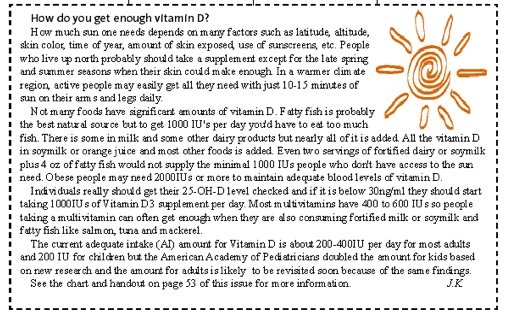Vitamin D Reduces Total Mortality
Vitamin D and its metabolites target more than 200 human genes that impact not only bone health but also immune function and many other bodily functions. However, the current government guideline for vitamin D requirement is based only on the need for vitamin D to prevent bone disease. That level may not be adequate to meet all other metabolic functions that utilize vitamin D. Low levels of vitamin D apparently impair immune function and increase the risk of at least several types of autoimmune diseases including multiple sclerosis, rheumatoid arthritis, psoriasis, and type 1 diabetes. A placebo-controlled trial of Nebraska women found that 1100 IU of vitamin D for 4 years cut their risk of developing breast, colon, and other internal cancers. 1 Even 1,100 IU may not be adequate to optimize immune function.

By James J. Kenney, PhD, RD, FACNReferences:1. Am J Clin Nutr 2007;85:1586-912. Expert Opin Pharmacother 2008;9:1-123. Arch Intern Med 2008;168:1174-804. Arch Intern Med 2007;167:1730-7How do you get enough vitamin D?How much sun one needs depends on many factors such as latitude, altitude, skin color, time of year, amount of skin exposed, use of sunscreens, etc. People who live up north probably should take a supplement except for the late spring and summer seasons when their skin could make enough. In a warmer climate region, active people may easily get all they need with just 10-15 minutes of sun on their arms and legs daily.Not many foods have significant amounts of vitamin D. Fatty fish is probably the best natural source but to get 1000 IU's per day you'd have to eat too much fish. There is some in milk and some other dairy products but nearly all of it is added. All the vitamin D in soymilk or orange juice and most other foods is added. Even two servings of fortified dairy or soymilk plus 4 oz of fatty fish would not supply the minimal 1000 IUs people who don't have access to the sun need. Obese people may need 2000IUs or more to maintain adequate blood levels of vitamin D.Individuals really should get their 25-OH-D level checked and if it is below 30ng/ml they should start taking 1000IUs of Vitamin D3 supplement per day. Most multivitamins have 400 to 600 IUs so people taking a multivitamin can often get enough when they are also consuming fortified milk or soymilk and fatty fish like salmon, tuna and mackerel.The current adequate intake (AI) amount for Vitamin D is about 200-400IU per day for most adults and 200 IU for children but the American Academy of Pediatricians doubled the amount for kids based on new research and the amount for adults is likely? to be revisited soon because of the same findings.See the chart and handout on page 53 of this issue for more information.?? ??? ??? ?J.K.


